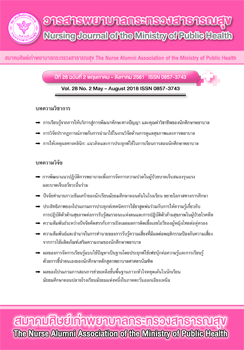Clinical Reasoning : Concept and Application for Learning and Teaching in Nursing Students
Main Article Content
Abstract
Abstract
Clinical reasoning is the essential cognitive skill that helps nursing students make clinically sound decisions. It is the thinking process which nurses use to assess and interpret information, evaluate crucial cues and make decisions regarding appropriate nursing care. Effective clinical reasoning processes can promote appropriate clinical decision making to improve quality and safety in nursing practice. Therefore, clinical reasoning is important for nursing practice. Teaching and learning for nursing students needs to focus on developing their clinical reasoning ability. Several teaching and learning methods, including think aloud, questioning, concept mapping, analogy and reflective thinking, can be employed to develop nursing students’ clinical reasoning skills. This article aims to provide a concept and application of clinical reasoning that can be used by instructors as a guideline to develop clinical reasoning ability for nursing students. This ability can bring effective clinical decision making to nursing practice.
Article Details
บทความและรายงานวิจัยในวารสารพยาบาลกระทรวงสาธารณสุข เป็นความคิดเห็นของ ผู้เขียน มิใช่ของคณะผู้จัดทำ และมิใช่ความรับผิดชอบของสมาคมศิษย์เก่าพยาบาลกระทรวงสาธารณสุข ซึ่งสามารถนำไปอ้างอิงได้
References
1. Kantar L, Alexander R. Integration of clinical judgment in the nursing curriculum : challenges and perspectives. Journal of
Nursing Education 2012;51(8): 444-53.
2. Banning M A. Review of clinical decision making: models and current research. Journal of Clinical Nursing 2008;17(2):187-95.
3. Alfaro-Lefevre R. Critical thinking critical reasoning and clinical Judgement. 5th ed. St. Louise: Sauders Elsevier;2013.
4. Simmons B. Clinical reasoning: concept analysis. Journal of Advanced Nursing 2010; 66(5):1151-58.
5. Johansen ML, O’Brien JL. Decision making in nursing practice: a concept analysis Nursing Forum 2016;51(1):40-48.
6. Lapkin S, Levett-Jones T, Bellchambers H, Fernandez R. Effectiveness of patient simulation manikins in teaching clinical
reasoning skills to undergraduate nursing students: a systematic review. Clinical Simulation in Nursing 2010; 6: e207-e222.
7. Killam LA, Luhanga F, Bakker D. Characteristics of unsafe undergraduate nursing students in clinical practice: an integrative literature review. Journal of Nurse Education 2011;50(8):437-46.
8. Tapaneeyakorn W, Kosolchuenvijit J, Anonrath K, Wannasuntad S, Smit P. Factors affecting clinical reasoning of nursing students at Boromarajonani College of Nursing Bangkok. Journal of Health Science Research 2016;10(1):70-77. (in Thai).
9. Narayan S, Corcoran-Perry S. Teaching clinical reasoning skills to undergraduate nursing. In: Higgs J, Jones MA, Loftus F, Christensen N, editors. Clinical reasoning in the health professions. 3rded. UK: Butterworth-Heinemann; 2008.
10. Tanner C. Thinking like a nurse: a research-based model of clinical judgment in nursing. Journal of Nursing Education 2006;45: 204-11.
11. Facione NC, Facione PA. Critical thinking and clinical judgment. In: Facione NC, Facione PA editors. Critical thinking and clinical reasoning in the health sciences: an international multidisciplinary teaching anthology Millbrae. CA: Insight Assessment/The California Academic Press;2008.
12. Fonteyn ME, Ritter BJ. Clinical reasoning in nursing. In: Higgs J, Jones MA, Loftus F, Christensen N, editors. Clinical
reasoning in the health professions. 3rded. UK: Butterworth-Heinemann;2008.
13. Levettt-Jones T, Hoffman K, Dempse J, Jeong SY, Noble D, Norton C, et.al. The ‘five rights’ of clinical reasoning: an educational model to enhance nursing students’ ability to identify and manage clinically at risk patients. Nurse Education Today 2010;30:515-20.
14. Sawekngam W. Reasoning ability required for students in 21st century. Journal of Education Study 2014;42(2):207-23.
(in Thai).
15. Bradford A. Deductive reasoning vsinductive reasoning. 2018 [cited January 8] available from https://www.livescience.com/21569-deduction-vs-induction.html.
16. Villegas de Posada C, Vargas-Trujillo E. Moral reasoning and personal behavior : a meta-analytical review. Review of
General Psychology 2015;19(4): 408–24.
17. Forsberg E, Ziegert K, Hult H, Fors U. Clinical reasoning in nursing, a think aloud study using virtual patients - A base for aninnovative assessment. Nurse Education Today 2014;34:538-42.
18. Benner P, Sutphen M, Leonard V, Day L. Educating nurses: a call for radical transformation. San Francisco: Jossey-Bass; 2010.
19. Simpson E, Courtney M. Implementation and evaluation of critical thinking strategies to enhance critical thinking skills in Middle Eastern nurses. International Journal of Nursing Practice.2008;14(6):449-54.
20. McMillan WJ. Teaching for clinical reasoning – helping students make the conceptual links. Journal Medical Teaching 2010;32:436–42.
21. Pottier P, Hardouin JB, Hodges BD, Pistorius MA, Connault J, Durant C, et al. Exploring how students think: a new method combining think-aloud and concept mapping protocol. Medical Education 2010; 44:926–35.
22. Lee W, Chiang CH, Liao IC, Lee ML, Chen SL, Liang T. The longitudinal effect of concept map teaching on critical thinking of nursing students. Nurse Education Today 2013;33:1219–23.
23. Sinatra-Wilhelm T. Nursing care plans versus concept maps in the enhancement of critical thinking skills in nursing students enrolled in a baccalaureate nursing program. Creative Nursing 2012;18(2):79-84.
24. Joyce B, Weil M, Calhoun E. Models of Teaching. 8th ed. Boston: Pearson Prentice Hall; 2011.
25. Edelen BG, Bell AA. The role of analogy-guided learning experiences in enhancing students’ clinical decision-making skills. Journal of Nursing Education 2011;50(8):453-460.
26. Atkins S, Schutz S. Developing skills for reflective practice. In: Bulman C, Schutz S, editors. Reflective Practice in ursing.5thed. Oxford: Wiley- Blackwell Science;2013.27.Barbour JF. The making of a butterfly: reflective practice in nursing education. International Journal for Human Caring 2013;17(3):7-11.
28. Howatson-Jones L. Reflective practice in nursing. 2nded. London : SAGE publication; 2013.
29. Asselin E. Using reflection strategies to link course knowledge to clinical practice: the RN-to-BSN student experience. Journal of Nursing Education 2011;50(3):125-33.
30. Carter B. Reflecting in groups. In: Bulman C, Schutz S, editors. Reflective practice in nursing.5thed. Oxford: Wiley-Blackwell Science;2013.
31. Johnson, JA. Reflective learning, reflective practice, and metacognition: the importance in nursing education. Journal of Nurses Professional Development 2013;29(1): 46-48.

